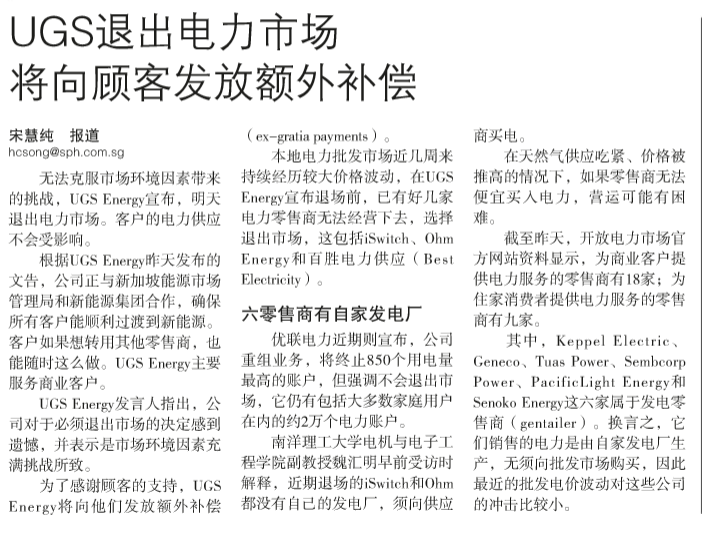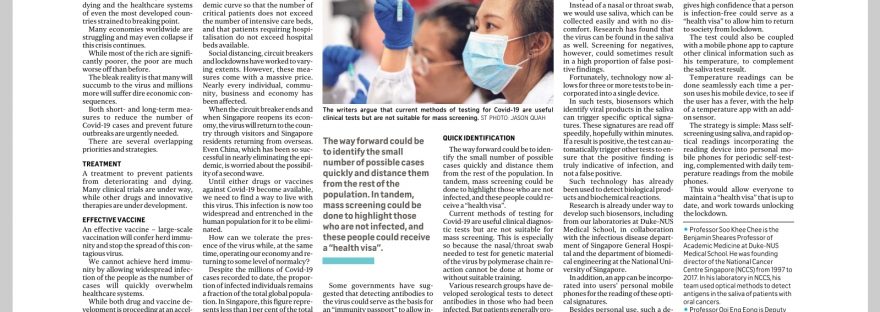By Soo Khee Chee & Ooi Eng Eong
The Covid-l9 pandemic has hit the world hard. In four months we have seen millions infected, thousands dying and the healthcare systems of even the most developed countries strained to breaking point.
Many economies worldwide are struggling and may even collapse if this crisis continues. While most of the rich are significantly poorer, the poor are much worse off than before. The bleak reality is that many will succumb to the virus and millions more will suffer dire economic consequences. Both short- and long-term measures to reduce the number of Covid-l9 cases and prevent future outbreaks are urgently needed.
There are several overlapping priorities and strategies.
TREATMENT
A treatment to prevent patients from deteriorating and dying. Many clinical trials are under way, while other drugs and innovative therapies are under development.
EFFECTIVE VACCINE
An effective vaccine – large-scale vaccination will confer herd immunity and stop the spread of this contagious virus. We cannot achieve herd immunity by allowing widespread infection of the people as the number of cases will quickly overwhelm healthcare systems.
While both drug and vaccine development is proceeding at an accelerated pace, there is still a mountain for researchers to climb. Scientists are trying to complete the bench-to-bedside journey for vaccine development — a process which normally takes more than 10 years — in a matter of months. Even through the most optimistic lens, it will be at least another year before a vaccine is ready for application.
FLATTENING THE CURVE
To continue to flatten the epidemic curve so that the number of critical patients does not exceed the number of intensive care beds, and that patients requiring hospitalisation do not exceed hospital beds available.
Social distancing, circuit breakers and Iockdowns have worked to varying extents. However, these measures come with a massive price. Nearly every individual, community, business and economy has been affected. When the circuit breaker ends and when Singapore reopens its economy, the virus will return to the country through visitors and Singapore residents returning from overseas. Even China, which has been so successful in nearly eliminating the epidemic, is worried about the possibility of a second wave.
Until either drugs or vaccines against Covid-19 become available, we need to find a way to live with this virus. This infection is now too widespread and entrenched in the human population for it to be eliminated. How can we tolerate the presence of the virus while, at the same time, operating our economy and returning to some level of normalcy?
Despite the millions of Covid-l9 cases recorded to date, the proportion of infected individuals remains a fraction of the total global population. In Singapore, this figure represents less than 1 per cent of the total number of Singapore residents. A lockdown of the Singapore population to prevent those infected from passing the virus to others is not sustainable in the medium or long term.
Some governments have suggested that detecting antibodies to the virus could serve as the basis for an “immunity passport” to allow individuals to travel or to return to work assuming that they are protected against reinfection. However, there is no evidence yet that people who have recovered are protected from a second infection.
QUICK IDENTIFICATION
The way forward could be to identify the small number of possible cases quickly and distance them from the rest of the population. In tandem, mass screening could be done to highlight those who are not infected, and these people could receive a “health visa”.
Current methods of testing for Covid-19 are useful clinical diagnostic tests but are not suitable for mass screening. This is especially so because the nasal/throat swab needed to test for genetic material of the virus by polymerase chain reaction cannot be done at home or without suitable training.
Various research groups have developed serological tests to detect antibodies in those who had been infected. But patients generally produce antibodies only after eight to 10 days, while it is believed that they are most contagious before antibodies develop. Therefore, serology is not particularly useful as a screening tool.
For a “health visa”, we would need a test where a negative result indicates no infection with high confidence. This is the same strategy we use to screen blood donors for HIV infection to make sure that blood products are safe. Instead of a nasal or throat swab, we would use saliva, which can he collected easily and with no discomfort. Research has found that the virus can be found in the saliva as well.
Screening for negatives, however, could sometimes result in a high proportion of false positive findings. Fortunately, technology now allows for three or more tests to be incorporated into a single device. In such tests. biosensors which identify viral products in the saliva can trigger specific optical signatures. These signatures are read off speedily, hopefully within minutes. If a result is positive, the test can automatically trigger other tests to ensure that the positive finding is truly indicative of infection, and not a false positive.
Such technology has already been used to detect biological products and biochemical reactions. Research is already under way to develop such biosensors, including from our laboratories at Duke-NUS Medical School, in collaboration with the infectious disease department of Singapore General Hospital and the department of biomedical engineering at the National University of Singapore.
In addition. an app can be incorporated into users’ personal mobile phones for the reading of these optical signatures. Besides personal use, such a device can also be used in situational testing, such as entry into cinemas, places of worship and sports events. Singapore has the technology and the expertise to develop such devices. Using a self-administered saliva-based test overcomes the disadvantages of lab or clinic-based testing. It would be similar to dip-stick tests for diabetes and pregnancy.
A test where a negative result gives high confidence that a person is infection-free could serve as a “health visa” to allow him to return to society from lockdown. The test could also be coupled with a mobile phone app to capture other clinical information such as his temperature, to complement the saliva test result. Temperature readings can be done seamlessly each time a person uses his mobile device, to see if the user has a fever, with the help of a temperature app with an add-on sensor.
The strategy is simple: Mass self-screening using saliva, and rapid optical readings incorporating the reading device into personal mobile phones for periodic self-testing, complemented with daily temperature readings from the mobile phones. This would allow everyone to maintain a “health visa” that is up to date, and work towards unlocking the lockdown.
Professor Soo Khee Chee is the Benjamin Sheares Professor of Academic Medicine at Duke-NUS Medical School. He was founding director of the National Cancer Centre Singapore (NCCS) from 1997 to 2017. In his laboratory in NCCS, his team used optical methods to detect antigens in the saliva of patients with oral cancers.
Professor Ooi Eng Eong is Deputy Director of the Emerging Infectious Diseases Programme at Duke-NUS Medical School. He is a three-time recipient of the National Medical Research Council Clinician-Scientist (Senior Investigator) Award.
This article was pitched to The Straits Times by Sunny Wee and first published on 9 May 2020 as part of the Covid-19 Special: Science Talk column.

